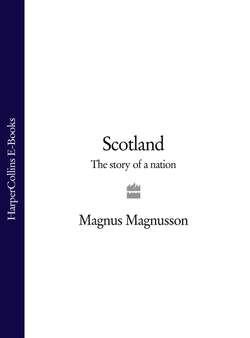Читать книгу Scotland: The Story of a Nation - Magnus Magnusson - Страница 37
The border issue
ОглавлениеMalcolm’s marriage connection with a claimant to the English throne may well have added fuel to his ambitions to extend his own kingdom by attacking Northumbria, allegedly on Edgar the Atheling’s behalf. His first opportunity came in 1070. Northumbria had fiercely resisted the Norman conquest of southern England, and had been savagely punished by King William. Malcolm launched his own invasion, ostensibly to help the English rebels, but it did little more than add to the cruel devastation of Yorkshire.
King William recognised the danger to the security of England posed by Malcolm’s aggression. In 1072 he invaded Scotland with a large, well-organised army, supported by a fleet; it was the first full-scale invasion of Scotland since Roman times. William marched through Lothian and across the River Forth at Stirling, and went on to the River Tay. Malcolm realised that his own forces were no match for the powerful host of Norman knights and men-at-arms, and refused to give battle. Frustrated by Malcolm’s delaying tactics, William offered to talk terms at Abernethy on the Tay. The treaty which resulted is known in English sources as the ‘Abernethy Submission’: Malcolm apparently submitted to William – ‘he gave hostages and was his man’. He agreed not to harbour the English king’s enemies (for instance, Edgar the Atheling), and surrendered his eldest son, Duncan (by Ingibjörg of Orkney), as a hostage. But was it a formal act of homage by a King of Scots as a vassal of England – or was Malcolm only recognising English suzerainty of the disputed lands of Cumbria and Northumbria? Ted Cowan believes that the idea of the King of Scots accepting the overlordship or ‘feudal superiority’ of the English king was a later fabrication by English chroniclers, designed to reinforce English claims to be rulers of Scotland; certainly, the ‘Abernethy Submission’ would remain a bone of contention between English and Scots constitutional lawyers for centuries to come.
Malcolm did not consider himself bound by it in any way. In 1079, when Norman control of the north of England was precarious once more, Malcolm invaded again – but again with no other result than a retaliatory invasion from England, led this time by William’s son, Robert Curthose. Malcolm, again, refused battle, and at Falkirk the terms of the Abernethy Treaty (such as they were) were renewed. It also seems that a border was agreed, stretching between the Solway and the Tyne. Certainly, it was immediately after the Falkirk meeting that Robert Curthose commissioned the building of a ‘New Castle’ on the Tyne. It was a motte-and-bailey, and was the foundation of modern Newcastle. The border was reinforced in 1091, after yet another indecisive incursion against Durham and a counter-incursion into Lothian, this time led by William’s successor on the throne of England, his son William Rufus (William II). William II took Carlisle and temporarily robbed the Scots of that part of ancient Cumbria which lay south of the Solway; he consolidated the western end of the ‘border’ by ordering the building of the first castle at Carlisle.
